一、Node.js基础
1. 认识Node.js
- nodejs 并不是
JavaScript应用,也不是编程语言,因为编程语言使用的JavaScript,Nodejs是JavaScript的运行时。- Nodejs是构建在V8引擎之上的,V8引擎是由C/C++编写的,因此我们的JavaSCript代码需要由C/C++转化后再执行。
- NodeJs 使用异步 I/O 和事件驱动的设计理念,可以高效地处理大量并发请求,提供了非阻塞式 I/O 接口和事件循环机制,使得开发人员可以编写高性能、可扩展的应用程序,异步I/O最终都是由
libuv事件循环库去实现的。- NodeJs 使用npm 作为包管理工具类似于python的pip,或者是java的Maven,目前npm拥有上百万个模块。 www.npmjs.com/
- nodejs适合干一些IO密集型应用,不适合CPU密集型应用,nodejsIO依靠libuv有很强的处理能力,而CPU因为nodejs单线程原因,容易造成CPU占用率高,如果非要做CPU密集型应用,可以使用C++插件编写 或者nodejs提供的
cluster。(CPU密集型指的是图像的处理 或者音频处理需要大量数据结构 + 算法)
01 nodejs的特性
- Nodejs语法完全是js语法,只要你懂js基础就可以学会Nodejs后端开发
- NodeJs超强的高并发能力,实现高性能服务器
- 开发周期短、开发成本低、学习成本低
02 使用 Node.js 需要了解多少 JavaScript
http://nodejs.cn/learn/how-much-javascript-do-you-need-to-know-to-use-nodejs
03 浏览器环境vs node环境
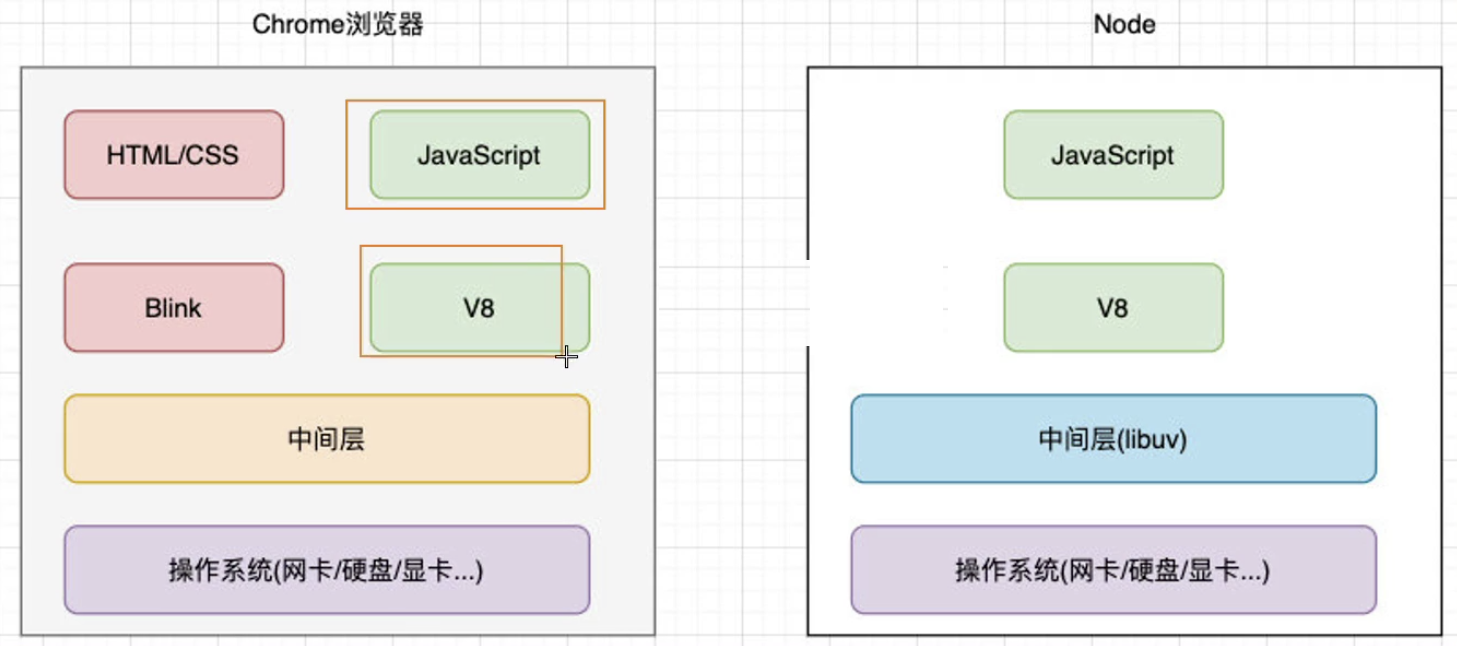
Node.js 可以解析JS代码(没有浏览器安全级别的限制)提供很多系统级别的API,如:
文件的读写 (File System)
jsconst fs = require('fs') fs.readFile('./ajax.png', 'utf-8', (err, content) => { console.log(content) })进程的管理 (Process)
jsfunction main(argv) { console.log(argv) } main(process.argv.slice(2))网络通信 (HTTP/HTTPS)
jsconst http = require("http") http.createServer((req,res) => { res.writeHead(200, { "content-type": "text/plain" }) res.write("hello nodejs") res.end() }).listen(3000)
2. 开发环境搭建

3. 模块、包、commonJS
Nodejs 模块化规范遵循两套一 套CommonJS规范另一套esm规范

01 CommonJS规范
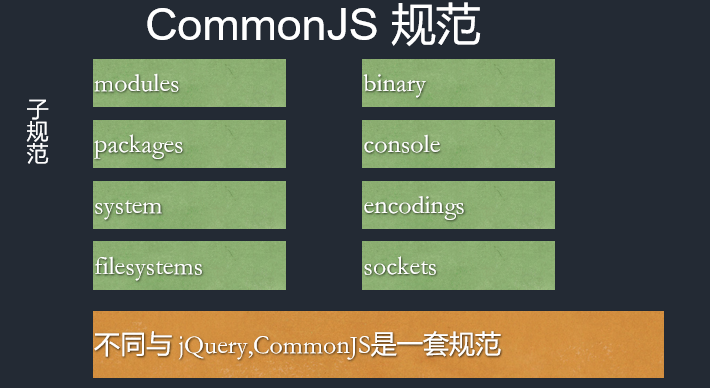
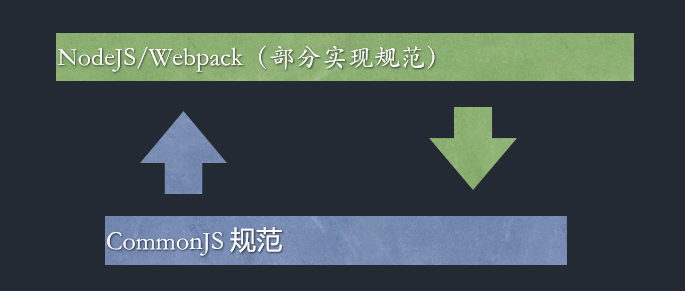
引入模块(require)支持四种格式
- 支持引入内置模块例如
httposfschild_process等nodejs内置模块 - 支持引入第三方模块
expressmd5koa等 - 支持引入自己编写的模块 ./ ../ 等
- 支持引入addon C++扩展模块
.node文件 - 支持引入
json文件
jsconst fs = require('node:fs'); // 导入核心模块 const express = require('express'); // 导入 node_modules 目录下的模块 const myModule = require('./myModule.js'); // 导入相对路径下的模块 const nodeModule = require('./myModule.node'); // 导入扩展模块 const data = require('./data.json') // 导入json文件- 支持引入内置模块例如
导出模块exports 和 module.exports
jsmodule.exports = { hello: function() { console.log('Hello, world!'); } }; // 如果不想导出对象直接导出值 module.exports = 123
02 modules模块化规范写法
引入模块 import 必须写在头部
注意使用ESM模块的时候必须开启一个选项 打开
package.json设置type:module
引入模块
jsimport fs from 'node:fs' // 导入核心模块 import hello from './test.js' // 导入相对路径下的模块 // 如果要引入json文件需要特殊处理 需要增加断言并且指定类型json node低版本不支持(实验特性) import data from './data.json' assert { type: "json" };jsimport * as all from './test.js' // 加载模块的整体对象 console.log(all) // 查看所有的导出导出模块, default只能有一个不可重复export default
jsexport const a = 1 // 导出一个默认对象 export default { name: 'test', }
03 Cjs 和 ESM 的区别
- Cjs是基于运行时的同步加载,esm是基于编译时的异步加载
- Cjs是可以修改值的,esm值并且不可修改(可读的)
- Cjs不可以tree shaking,esm支持tree shaking
- commonjs中顶层的this指向这个模块本身,而ES6中顶层this指向undefined
4. Npm
npm(全称 Node Package Manager)是 Node.js 的包管理工具,它是一个基于命令行的工具,用于帮助开发者在自己的项目中安装、升级、移除和管理依赖项。
01 npm的使用
npm init // 初始化一个新的 npm 项目,创建 package.json 文件
npm install 包名 –g (uninstall,update) // 安装包,-g表示全局安装
npm install 包名 --save-dev (uninstall,update) // 安装开发依赖,简写(npm i 包名 -D)
npm list -g // 不加-g,列举当前目录下的安装包
npm info 包名(详细信息) npm info 包名 version(获取最新版本)
npm install md5@1 //安装指定版本
npm outdated // 列出当前项目中需要更新的包。
npm config list // 用于列出所有的 npm 配置信息。
npm config set registry 网址 // 切换镜像源02 全局安装 nrm
NRM (npm registry manager)是npm的镜像源管理工具,有时候国外资源太慢,使用这个就可以快速地在 npm 源间切换。
手动切换方法: npm config set registry https://registry.npm.taobao.org
安装 nrm
在命令行执行命令,npm install -g nrm,全局安装nrm。
使用 nrm
执行命令 nrm ls 查看可选的源。 其中,带*的是当前使用的源,上面的输出表明当前源是官方源。
切换 nrm
如果要切换到taobao源,执行命令nrm use taobao。
测试速度
你还可以通过 nrm test 测试相应源的响应时间。
nrm testnpm install -g cnpm --registry=https://registry.npmmirror.com03 yarn使用
npm install -g yarn对比npm:
速度超快: Yarn 缓存了每个下载过的包,所以再次使用时无需重复下载。 同时利用并行下载以最大化资源利用率,因此安装速度更快。
超级安全: 在执行代码之前,Yarn 会通过算法校验每个安装包的完整性。
开始新项目
yarn init
添加依赖包
yarn add [package]
yarn add [package]@[version]
yarn add [package] --dev
升级依赖包
yarn upgrade [package]@[version]
移除依赖包
yarn remove [package]
安装项目的全部依赖
yarn install04 Package json
执行npm init 便可以初始化一个package.json
name:项目名称,必须是唯一的字符串,通常采用小写字母和连字符的组合。version:项目版本号,通常采用语义化版本号规范。description:项目描述。main:项目的主入口文件路径,通常是一个 JavaScript 文件。keywords:项目的关键字列表,方便他人搜索和发现该项目。author:项目作者的信息,包括姓名、邮箱、网址等。license:项目的许可证类型,可以是自定义的许可证类型或者常见的开源许可证(如 MIT、Apache 等)。dependencies:项目所依赖的包的列表,这些包会在项目运行时自动安装。devDependencies:项目开发过程中所需要的包的列表,这些包不会随项目一起发布,而是只在开发时使用。peerDependencies:项目的同级依赖,即项目所需要的模块被其他模块所依赖。scripts:定义了一些脚本命令,比如启动项目、运行测试等。repository:项目代码仓库的信息,包括类型、网址等。bugs:项目的 bug 报告地址。homepage:项目的官方网站地址或者文档地址。
version 三段式版本号一般是1.0.0 大版本号 次版本号 修订号, 大版本号一般是有重大变化才会升级, 次版本号一般是增加功能进行升级, 修订号一般是修改bug进行升级
npm install 安装模块的时候一般是扁平化安装的,但是有时候出现嵌套的情况是因为版本不同 A 依赖 C1.0, B 依赖 C1.0, D 依赖 C2.0, 此时C 1.0就会被放到A B的node_moduels, C2.0 会被放入D模块下面的node_moduels
05 Npm install 原理
首先安装的依赖都会存放在根目录的node_modules,默认采用扁平化的方式安装,并且排序规则.bin第一个然后@系列,再然后按照首字母排序abcd等,并且使用的算法是广度优先遍历,在遍历依赖树时,npm会首先处理项目根目录下的依赖,然后逐层处理每个依赖包的依赖,直到所有依赖都被处理完毕。在处理每个依赖时,npm会检查该依赖的版本号是否符合依赖树中其他依赖的版本要求,如果不符合,则会尝试安装适合的版本。
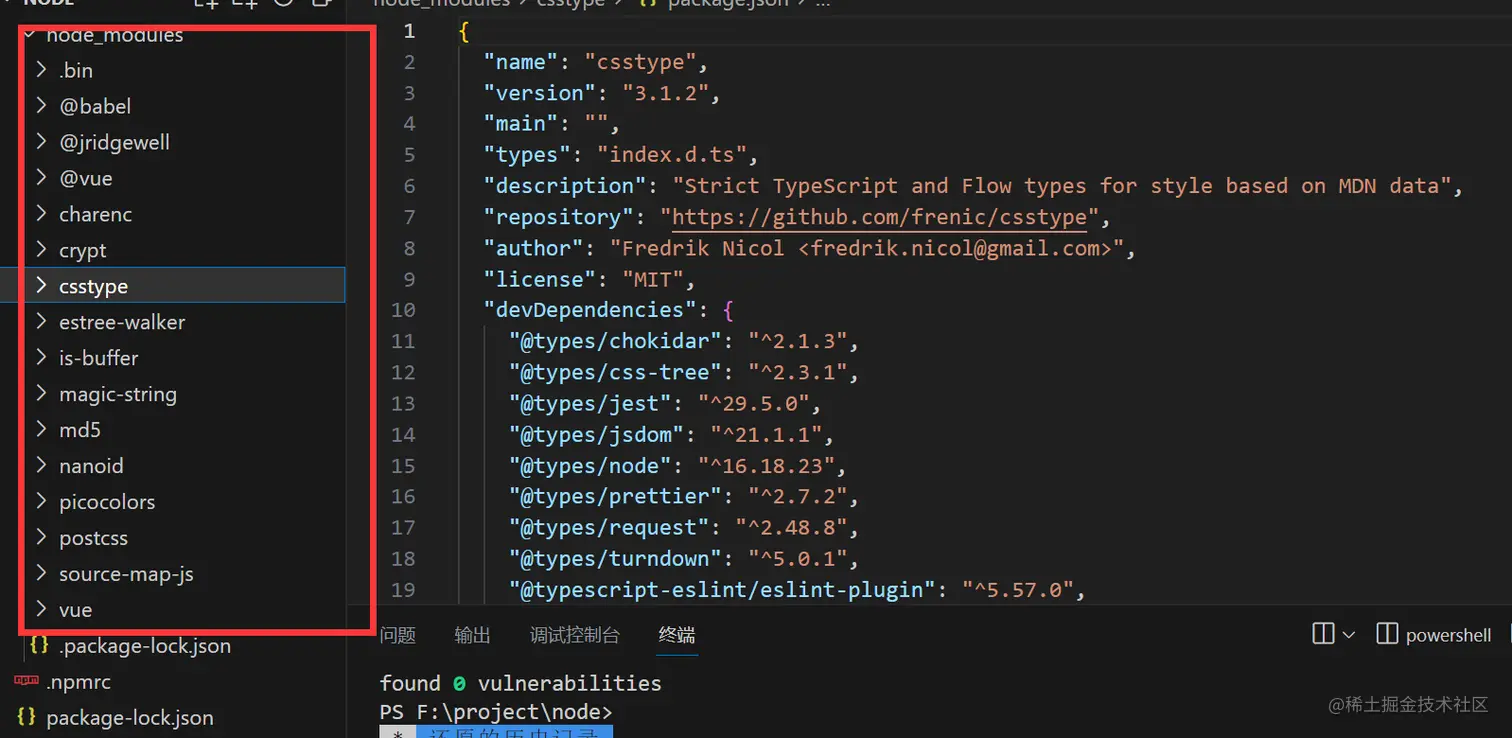
扁平化只是理想状态如下
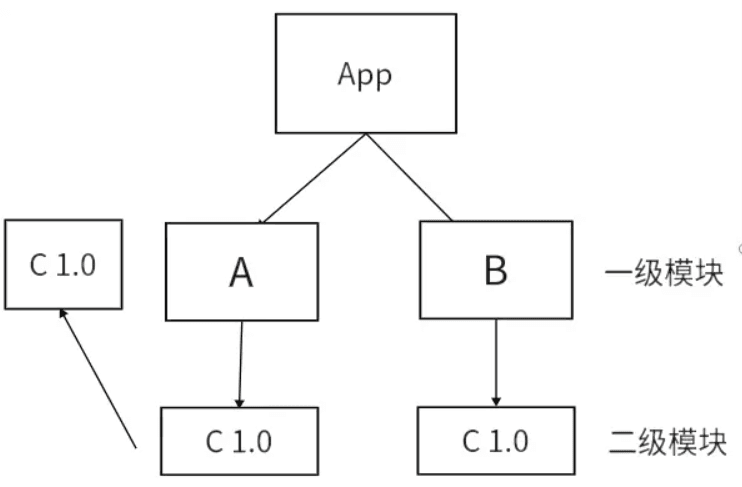
- 安装某个二级模块时,若发现第一层级有相同名称,相同版本的模块,便直接复用那个模块
- 因为A模块下的C模块被安装到了第一级,这使得B模块能够复用处在同一级下;且名称,版本,均相同的C模块
非理想状态下
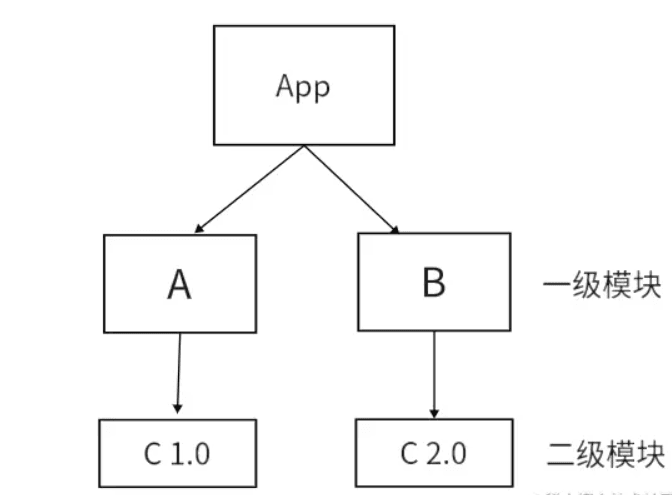
- 因为B和A所要求的依赖模块不同,(B下要求是v2.0的C,A下要求是v1.0的C )所以B不能像2中那样复用A下的C v1.0模块 所以如果这种情况还是会出现模块冗余的情况,他就会给B继续搞一层node_modules,就是非扁平化了。
npm install 后续流程

06 package-lock.json
很多朋友只知道这个东西可以锁定版本记录依赖树详细信息
- version 该参数指定了当前包的版本号
- resolved 该参数指定了当前包的下载地址
- integrity 用于验证包的完整性
- dev 该参数指定了当前包是一个开发依赖包
- bin 该参数指定了当前包中可执行文件的路径和名称
- engines 该参数指定了当前包所依赖的Node.js版本范围
知识点来了,package-lock.json 帮我们做了缓存,他会通过 name + version + integrity 信息生成一个唯一的key,这个key能找到对应的index-v5 下的缓存记录,也就是npm cache 文件夹下的。如果发现有缓存记录,就会找到tar包的hash值,然后将对应的二进制文件解压到node_modeules
07 npm 生命周期
"predev": "node prev.js",
"dev": "node index.js",
"postdev": "node post.js"执行 npm run dev 命令的时候 predev 会自动执行 他的生命周期是在dev之前执行,然后执行dev命令,再然后执行postdev,也就是dev之后执行
运用场景例如npm run build 可以在打包之后删除dist目录等等
post例如你编写完一个工具发布npm,那就可以在之后写一个ci脚本顺便帮你推送到git等等
谁用到了例如vue-cli github.com/vuejs/vue-c…
08 npx
npx是一个命令行工具,它是npm 5.2.0版本中新增的功能。它允许用户在不安装全局包的情况下,运行已安装在本地项目中的包或者远程仓库中的包。
npx的作用是在命令行中运行node包中的可执行文件,而不需要全局安装这些包。这可以使开发人员更轻松地管理包的依赖关系,并且可以避免全局污染的问题。它还可以帮助开发人员在项目中使用不同版本的包,而不会出现版本冲突的问题。
npx 的优势
- 避免全局安装:
npx允许你执行npm package,而不需要你先全局安装它。 - 总是使用最新版本:如果你没有在本地安装相应的npm package,
npx会从npm的package仓库中下载并使用最新版。 - 执行任意npm包:
npx不仅可以执行在package.json的scripts部分定义的命令,还可以执行任何npm package。 - 执行GitHub gist:
npx甚至可以执行GitHub gist或者其他公开的JavaScript文件。
npm 和 npx 区别:
npx侧重于执行命令的,执行某个模块命令。虽然会自动安装模块,但是重在执行某个命令
npm侧重于安装或者卸载某个模块的。重在安装,并不具备执行某个模块的功能。
09 发布npm包
- 方便团队或者跨团队共享代码,使用npm包就可以方便的管理,并且还可以进行版本控制
- 做开源造轮子必备技术,否则你做完的轮子如何让别人使用难道是U盘拷贝?
- 面试题我面字节的时候就问到了这个
- 增加个人IP 让更多的人知道你的技术能力和贡献
下面的操作都要必须要用npm源才行
注册账号。也可以直接取官网注册,作用一样。
bash# 打开网址注册账户 npm adduser登录账号
bashnpm login发布包
bashnpm publish如果出现403说明包名被占用了 或 版本重复
5. 内置模块
01 全局变量
在nodejs中使用global定义全局变量,定义的变量。在浏览器中我们定义的全局变量都在window中。不同的环境还需要判断,于是在ECMAScript 2020 出现了一个globalThis全局变量,在nodejs环境会自动切换成global ,浏览器环境自动切换window非常方便。
globalThis.name = 'yage'关于其他全局API:
__dirname:当前模块的所在目录的绝对路径__filename:当前模块文件的绝对路径,包括文件名和文件扩展名process:全局对象,可以在任何模块中直接访问,无需导入或定义。Buffer: 全局对象,可以在任何模块中直接访问,无需导入或定义。
02 path模块
const path = require('node:path')
// 1。返回文件名
console.log(path.basename(__filename))
// 2. 返回文件路径,正好和basename互补
console.log(path.dirname(__filename));
// 3. 返回文件后缀名
console.log(path.extname(__filename));
// 4. 拼接路径
console.log(path.join('./a', 'b', 'c'));
// 5. 返回绝对路径(如果都是绝对路径返回最后一个)
console.log(path.resolve('./a', 'b', 'c'))
// 6. 路径 --> 对象
console.log(path.parse(__filename));
// 7. 对象 --> 路径
console.log(path.format({
root: 'e:\\',
dir: 'e:\\DemoCode\\yage',
base: 'main.js',
ext: '.js',
name: 'main'
}));
// 8. 路径分隔符
console.log(path.sep)03 OS模块
const os = require('node:os')
// 1. 获取操作系统平台 -- win32
console.log(os.platform())
// 2. 获取操作系统发行版本 -- 10.0.22631
console.log(os.release());
// 3. 获取操作系统类型 -- Windows_NT
console.log(os.type());
// 4. 获取操作系统版本 -- Windows 11 Pro
console.log(os.version());
// 5. 获取操作系统架构 -- x64
console.log(os.arch());
// 6. 获取操作系统用户目录 -- C:\Users\Administrator
console.log(os.homedir());
// 7. 获取操作系统CPU信息 -- [Object]
console.log(os.cpus());
// 8. 获取操作系统网络接口信息 -- [Object]
console.log(os.networkInterfaces());04 process
const path = require('node:process')
// 1. 获取操作系统信息,和os.arch()一样
console.log(process.arch);
// 2. 获取操作系统平台信息,和os.platform()一样
console.log(process.platform);
// 3. 获取命令行参数 -- [数组](前面2项是node路径和js文件路径,后面的是参数)
console.log(process.argv);
// 4. 获取当前工作目录(esm模式下用不了__dirname,可以用cwd代替)
console.log(process.cwd());
// 5. 获取内存使用情况
console.log(process.memoryUsage());
// 6. 退出进程
process.exit()
// 7. 杀死进程
process.kill(pid)
// 8. 获取环境变量(可以修改,但是只在当前进程下生效)
console.log(process.env);05 child_process
创建一个新的子进程来执行指定的命令,共有7个API Sync同步API 不加是异步API。
- 以下命令都要一个可选项,options:
cwd子进程的当前工作目录。默认值:process.cwd()。env环境变量键值对。默认值:process.env。encoding默认值:utf8shell用于执行命令的 shell。参见 Shell 要求 和 默认 Windows shell。默认值:Unix 上为/bin/sh,Windows 上为process.env.ComSpec。signal允许使用 AbortSignal 中止子进程。timeout默认值:0maxBuffer标准输出或标准错误上允许的最大数据量(以字节为单位)。如果超过,则子进程将终止并截断任何输出。killSignal默认值:SIGTERMuid设置进程的用户身份。gid设置进程的组标识。windowsHide隐藏通常在 Windows 系统上创建的子进程控制台窗口。默认值:false。
const cp = require('child_process');
// 1. 执行shell命令,传参可以直接在后面加。
// ecec返回buffer,buffer的大小是200k,如果超出会报错。
// 异步
cp.exec('node -v',(err,stdout,stderr)=>{
if(err){
console.log(err);
}else{
console.log(stdout);
}
})
//同步
const nodeVersion = cp.execSync('node -v'); // 返回buffer
console.log(nodeVersion.toString());
// 2. spawn 用于执行一些实时获取的信息,因为spawn返回的是流边执行边返回
// spawn在执行完成后会抛出close事件监听,并返回状态码,通过状态码可以知道子进程是否顺利执行。
const {stdout} = cp.spawn('netstat')
stdout.on('data',(msg)=>{
console.log(msg.toString());
})
stdout.on('close',()=>{
console.log('结束');
})
// 3. 执行可执行文件
cp.execFile('./bat.cmd',null,(err,stdout,stderr)=>{
if(err){
console.log(err);
}else{
console.log(stdout);
}
})
// 4. 只能接受js模块,场景适合大量的计算,或者容易阻塞主进程操作的一些代码,就适合开发fork
const testProcess = fork('./test.js')
// 主进程向子进程发送消息和接受消息
testProcess.send('我是主进程')
testProcess.on('message',(res)=>{
console.log('收到消息:',res);
})
// test.js 监听主进程发来的消息和发送消息
process.on('message',(msg)=>{
console.log('收到消息:',msg);
})
process.send('我是子进程')06 util模块
const util = require('node:util');
const fs = require('node:fs');
// 1. 异步函数 --> promise
const readPromise = util.promisify(fs.readFile);
readPromise('main.less','utf-8').then(res=>{
console.log(res)
}).catch(err=>{
console.log(err)
})
// 2. promise --> 回调函数
const fn = (type) => {
if(type == 1){
return Promise.resolve('test')
}
return Promise.reject('error')
}
const callback = util.callbackify(fn)
callback(1222,(err,val)=>{
console.log(err,val)
})
// 3. 格式化字符串
// %s:将参数作为字符串插入。
// %d 或 %i:将参数作为整数插入。
// %f:将参数作为浮点数插入,可选地指定小数位数(如 %f.2 表示两位小数)。
// %j:将参数(通常是对象或数组)作为 JSON 字符串插入。
// %o 或 %O:将参数(通常是对象)作为可供 console.log() 输出的格式插入。
// %%:插入一个字面的 '%' 符号。
console.log(util.format('%s---%s','name','age')); // name---age07 fs模块
在 Node.js 中,fs 模块是文件系统模块(File System module)的缩写,它提供了与文件系统进行交互的各种功能。通过 fs 模块,你可以执行诸如读取文件、写入文件、更改文件权限、创建目录等操作,Node.js 核心API之一。
- fs支持同步和异步两种模式 增加了
Syncfs 就会采用同步的方式运行代码,会阻塞下面的代码,不加Sync就是异步的模式不会阻塞。 - fs新增了promise版本,只需要在引入包后面增加/promise即可,fs便可支持promise回调。
- fs返回的是一个buffer二进制数据 每两个十六进制数字表示一个字节
// 以下是三种方式使用示例,以下方法都可以使用这三种方式
const fs = require('node:fs')
const fs2 = require('node:fs/promises')
// 1. 读取文件,异步方式
fs.readFile('./data.txt',{
encoding:'utf-8',
flag:'r'
},(err,data)=>{
if(err) throw err
console.log(data);
})
// 2. 读取文件,同步方式
const data = fs.readFileSync('./data.txt',{
encoding:'utf-8',
flag:'r'
})
console.log(data);
// 3. 读取文件,promise方式
fs2.readFile('./data.txt',{
encoding:'utf-8',
flag:'r'
}).then(data=>{
console.log(data);
}).catch(err=>{
throw err
})const fs = require('node:fs')
// 1. 可读流(适合处理大文件)
const readStream = fs.createReadStream('./data.txt')
readStream.on('data', (chunk) => {
console.log(chunk.toString())
})
readStream.on('end', () => {
console.log('读取完成了')
})
// 2. 可写流(适合处理大文件)
const writeStream = fs.createWriteStream('./data.txt')
writeStream.write('hello')
writeStream.write('world')
writeStream.end()
writeStream.on('finish', () => {
console.log('写入完成')
})
// 3. 写入文件
fs.writeFileSync('./data.txt','hello world')
// 追加文件
fs.writeFileSync('./data.txt','hello world',{
flag:'a'
})
// 追加文件
fs.appendFileSync('./data.txt','hello world')
// 4. 创建文件夹(一般用同步)
fs.mkdirSync('./test')
// 递归创建
fs.mkdirSync('./test/test2',{
recursive:true
})
// 5. 删除文件夹
fs.rmdirSync('./test')
// 递归删除
fs.rmdirSync('./test/test2',{
recursive:true
})
// 6. 删除文件或文件夹,也可以递归删除
fs.rmSync('./data.txt')
// 7. 重命名文件
fs.renameSync('./data.txt','./dataNew.txt')
// 8. 监听文件变化 -- change data.txt
fs.watch('./data.txt',(eventType,filename)=>{
console.log(eventType,filename)
})
// 9. 监控文件元数据变化,文件的大小、修改时间(mtime)、访问时间(atime)等
fs.watchFile('data.txt', (curr, prev) => {
console.log(`the current mtime is: ${curr.mtime}`)
console.log(`the previous mtime was: ${prev.mtime}`)
})
// 10. 创建硬链接(共享内存地址)
fs.linkSync('./index.txt', './index2.txt')
// 11. 创建软链接
fs.symlinkSync('./index.txt', './index3.txt' ,"file") //软连接const fs = require('fs')
// pipe()能把一个文件流和另一个文件流串起
const readstream = fs.createReadStream('./1.txt')
const writestream = fs.createWriteStream('./2.txt')
readstream.pipe(writestream)08 crypto
- 对称加密
const crypto = require('node:crypto');
// 生成一个随机的 16 字节的初始化向量 (IV)
const iv = Buffer.from(crypto.randomBytes(16));
// 生成一个随机的 32 字节的密钥
const key = crypto.randomBytes(32);
// 创建加密实例,使用 AES-256-CBC 算法,提供密钥和初始化向量
const cipher = crypto.createCipheriv("aes-256-cbc", key, iv);
// 对输入数据进行加密,并输出加密结果的十六进制表示
cipher.update("小满zs", "utf-8", "hex");
const result = cipher.final("hex");
console.log(result);
// 解密
const de = crypto.createDecipheriv("aes-256-cbc", key, iv);
de.update(result, "hex");
const decrypted = de.final("utf-8");
console.log("Decrypted:", decrypted);- 非对称加密
const crypto = require('node:crypto')
// 生成 RSA 密钥对
const { privateKey, publicKey } = crypto.generateKeyPairSync('rsa', {
modulusLength: 2048,
});
// 要加密的数据
const text = '小满zs';
// 使用公钥进行加密
const encrypted = crypto.publicEncrypt(publicKey, Buffer.from(text, 'utf-8'));
console.log(encrypted.toString("hex")); // 查看加密后16进制数据
// 使用私钥进行解密
const decrypted = crypto.privateDecrypt(privateKey, encrypted);
console.log(decrypted.toString()); // 解密- 哈希函数
const crypto = require('node:crypto');
const md5 = (data) => {
// 创建哈希对象,并使用 MD5 算法
const hash = crypto.createHash('md5');
// 更新哈希对象的数据,update()方法需要一个字符串或Buffer类型的参数
hash.update(String(data));
// 计算哈希值,并以十六进制字符串形式输出
return hash.digest('hex');
};
console.log(md5(123456));09 Zlib
在 Node.js 中,zlib 模块提供了对数据压缩和解压缩的功能,以便在应用程序中减少数据的传输大小和提高性能。该模块支持多种压缩算法,包括 Deflate、Gzip 和 Raw Deflate。
Gzip算法
const zlib = require('zlib'); // zlib 模块提供数据压缩和解压缩功能
const fs = require('node:fs'); // 引入 Node.js 的 fs 模块用于文件操作
// 1. gzip压缩文件
// 创建可读流和可写流
const readStream = fs.createReadStream('index.txt');
const writeStream = fs.createWriteStream('index.txt.gz');
// 使用管道将可读流中的数据通过 Gzip 压缩,再通过管道传输到可写流中进行写入
readStream.pipe(zlib.createGzip()).pipe(writeStream)
// 2. gzip解压文件
const readStream = fs.createReadStream('index.txt.gz')
const writeStream = fs.createWriteStream('index2.txt')
readStream.pipe(zlib.createGunzip()).pipe(writeStream)Deflate算法
// 1. Deflate压缩文件
const readStream = fs.createReadStream('index.txt');
const writeStream = fs.createWriteStream('index.txt.deflate');
readStream.pipe(zlib.createDeflate()).pipe(writeStream);
// 2. Deflate解压文件
const readStream = fs.createReadStream('index.txt.deflate')
const writeStream = fs.createWriteStream('index3.txt')
readStream.pipe(zlib.createInflate()).pipe(writeStream)gzip 和 deflate 区别
- Deflate 是一种具体的压缩算法,基于 LZ77 算法(Lempel-Ziv coding)和 Huffman 编码的结合,用于减少数据存储或传输所需的字节数。它是无损压缩,意味着解压后能够恢复原始数据。
- Gzip 格式内部使用 Deflate 算法作为其核心的压缩机制。当你使用 Gzip 对数据进行压缩时,实际上是先使用 Deflate 算法对数据进行压缩,然后再将其封装在一个包含特定头部信息(如文件名、修改时间、CRC校验等)和尾部信息的 Gzip 容器中。
// http请求压缩
const zlib = require('zlib');
const http = require('node:http');
const server = http.createServer((req,res)=>{
const txt = '小满zs'.repeat(10000);
res.writeHead(200,{
// 'Content-Encoding':'gzip',
'Content-Encoding':'deflate',
'content-type':'text/plan;charset=utf-8'
})
const result = zlib.deflateSync(txt);
res.end(result)
})
server.listen(80)10 url模块
url.parse方法因为采用的是传统的urlObject,不符合现行的URL标准-WHATWG URL API,因此被官方弃用了。同时,与之相关的url.format()和url.resolve()方法也被弃用。官方推荐使用新的URL类来替代这些方法。
const urlStr = 'https://www.baidu.com:443/ad/index.html?id=8&name=mouse#tag=110';
const url1 = new URL(urlStr);
const url2 = new URL('/admin', 'http://127.0.0.1);
console.log(url1,url2)
// 获取查询参数的值
console.log(url.searchParams.get('id'));11 http模块
const http = require('node:http'); // 引入 http 模块
const url = require('node:url'); // 引入 url 模块
// 创建 HTTP 服务器,并传入回调函数用于处理请求和生成响应
http.createServer((req, res) => {
// 解析请求的 URL,获取路径和查询参数
const { pathname, query } = url.parse(req.url, true);
if (req.method === 'POST') { // 检查请求方法是否为 POST
if (pathname === '/login') { // 检查路径是否为 '/login'
let data = '';
req.on('data', (chunk) => {
data += chunk; // 获取 POST 请求的数据
console.log(data);
});
req.on('end', () => {
// 设置响应头的 Content-Type 为 'application/json'
res.setHeader('Content-Type', 'application/json');
res.statusCode = 200; // 设置响应状态码为 200
res.end(data); // 将获取到的数据作为响应体返回
});
} else {
// 设置响应头的 Content-Type 为 'application/json'
res.setHeader('Content-Type', 'application/json');
res.statusCode = 404; // 设置响应状态码为 404
res.end('Not Found'); // 返回 'Not Found' 作为响应体
}
} else if (req.method === 'GET') { // 检查请求方法是否为 GET
if (pathname === '/index') { // 检查路径是否为 '/index'
console.log(query.a); // 打印查询参数中的键名为 'a' 的值
res.end('get success'); // 返回 'get success' 作为响应体
}
}
}).listen(8080, () => {
console.log('server is running on port 8080'); // 打印服务器启动的信息
});12 Http动静分离
动静分离是一种在Web服务器架构中常用的优化技术,旨在提高网站的性能和可伸缩性。它基于一个简单的原则:将动态生成的内容(如动态网页、API请求)与静态资源(如HTML、CSS、JavaScript、图像文件)分开处理和分发。
这里静态资源使用缓存提高效率。
import http from 'node:http' // 导入http模块
import fs from 'node:fs' // 导入文件系统模块
import path from 'node:path' // 导入路径处理模块
import mime from 'mime' // 导入mime模块
const server = http.createServer((req, res) => {
const { url, method } = req
// 处理静态资源
if (method === 'GET' && url.startsWith('/static')) {
const filePath = path.join(process.cwd(), url) // 获取文件路径
const mimeType = mime.getType(filePath) // 获取文件的MIME类型
console.log(mimeType) // 打印MIME类型
fs.readFile(filePath, (err, data) => { // 读取文件内容
if (err) {
res.writeHead(404, {
"Content-Type": "text/plain" // 设置响应头为纯文本类型
})
res.end('not found') // 返回404 Not Found
} else {
res.writeHead(200, {
"Content-Type": mimeType, // 设置响应头为对应的MIME类型
"Cache-Control": "public, max-age=3600" // 设置缓存控制头
})
res.end(data) // 返回文件内容
}
})
}
// 处理动态资源
if ((method === 'GET' || method === 'POST') && url.startsWith('/api')) {
// ...处理动态资源的逻辑
}
})
server.listen(80) // 监听端口8012 http模块补充
12.1 接口:jsonp
const http = require('http')
const url = require('url')
const app = http.createServer((req, res) => {
let urlObj = url.parse(req.url, true)
switch (urlObj.pathname) {
case '/api/user':
res.end(`${urlObj.query.cb}({"name": "gp145"})`)
break
default:
res.end('404.')
break
}
})
app.listen(8080, () => {
console.log('localhost:8080')
})12.2 跨域:CORS
const http = require('http')
const url = require('url')
const querystring = require('querystring')
const app = http.createServer((req, res) => {
let data = ''
let urlObj = url.parse(req.url, true)
res.writeHead(200, {
'content-type': 'application/json;charset=utf-8',
'Access-Control-Allow-Origin': '*'
})
req.on('data', (chunk) => {
data += chunk
})
req.on('end', () => {
responseResult(querystring.parse(data))
})
function responseResult(data) {
switch (urlObj.pathname) {
case '/api/login':
res.end(JSON.stringify({
message: data
}))
break
default:
res.end('404.')
break
}
}
})
app.listen(8080, () => {
console.log('localhost:8080')
})12.3 模拟get
var http = require('http')
var https = require('https')
// 1、接口 2、跨域
const server = http.createServer((request, response) => {
var url = request.url.substr(1)
var data = ''
response.writeHeader(200, {
'content-type': 'application/json;charset=utf-8',
'Access-Control-Allow-Origin': '*'
})
https.get(`https://m.lagou.com/listmore.json${url}`, (res) => {
res.on('data', (chunk) => {
data += chunk
})
res.on('end', () => {
response.end(JSON.stringify({
ret: true,
data
}))
})
})
})
server.listen(8080, () => {
console.log('localhost:8080')
})12.4 模拟post:服务器提交(攻击)
const https = require('https')
const querystring = require('querystring')
const postData = querystring.stringify({
province: '上海',
city: '上海',
district: '宝山区',
address: '同济支路199号智慧七立方3号楼2-4层',
latitude: 43.0,
longitude: 160.0,
message: '求购一条小鱼',
contact: '13666666',
type: 'sell',
time: 1571217561
})
const options = {
protocol: 'https:',
hostname: 'ik9hkddr.qcloud.la',
method: 'POST',
port: 443,
path: '/index.php/trade/add_item',
headers: {
'Content-Type': 'application/x-www-form-urlencoded',
'Content-Length': Buffer.byteLength(postData)
}
}
function doPost() {
let data
let req = https.request(options, (res) => {
res.on('data', chunk => data += chunk)
res.on('end', () => {
console.log(data)
})
})
req.write(postData)
req.end()
}
// setInterval(() => {
// doPost()
// }, 1000)12.5 爬虫
const https = require('https')
const http = require('http')
const cheerio = require('cheerio')
http.createServer((request, response) => {
response.writeHead(200, {
'content-type': 'application/json;charset=utf-8'
})
const options = {
// protocol: 'https:',
hostname: 'i.maoyan.com',
port: 443,
path: '/',
method: 'GET'
}
const req = https.request(options, (res) => {
let data = ''
res.on('data', (chunk) => {
data += chunk
})
res.on('end', () => {
filterData(data)
})
})
function filterData(data) {
// console.log(data)
let $ = cheerio.load(data)
let $movieList = $('.column.content')
console.log($movieList)
let movies = []
$movieList.each((index, value) => {
movies.push({
title: $(value).find('.movie-title .title').text(),
detail: $(value).find('.detail .actor').text(),
})
})
response.end(JSON.stringify(movies))
}
req.end()
}).listen(3000)13 event模块
const EventEmitter = require('events')
class MyEventEmitter extends EventEmitter {}
const event = new MyEventEmitter()
event.on('play', (movie) => {
console.log(movie)
})
event.emit('play', '我和我的祖国')
event.emit('play', '中国机长')6. 外置模块
md5
const md5 = require('md5');
console.log(md5(123456));http-proxy-middleware
反向代理(Reverse Proxy)是一种网络通信模式,它充当服务器和客户端之间的中介,将客户端的请求转发到一个或多个后端服务器,并将后端服务器的响应返回给客户端。
// index.js 实现层
const http = require('node:http');
const fs = require('node:fs')
const url = require('node:url')
const {createProxyMiddleware} = require('http-proxy-middleware')
const config = require('./proxy.config.js')
const html = fs.readFileSync('./index.html') //给html文件起个服务
const server = http.createServer((req, res) => {
const {pathname} = url.parse(req.url)
const proxyList = Object.keys(config.server.proxy) //获取代理的路径
//如果请求的路径在里面匹配到 就进行代理
if(proxyList.includes(pathname)){
const proxy = createProxyMiddleware(config.server.proxy[pathname]) //代理
proxy(req,res)
return
}
console.log(proxyList)
res.writeHead(200, {
'Content-Type': 'text/html'
})
res.end(html) //返回html
})
server.listen(80) //监听端口// proxy.config.js 配置proxy代理
module.exports = {
server:{
proxy:{
//代理的路径
'/api': {
target: 'http://localhost:3000', //转发的地址
changeOrigin: true, //是否有跨域
// 可以重写路由
// rewirte:(path)=>{
// return path.replace('/api','')
// }
}
}
}
}// server.js 配置服务器
const http = require('node:http')
const url = require('node:url')
http.createServer((req, res) => {
const {pathname} = url.parse(req.url)
if(pathname === '/api'){
res.end('success proxy')
}
}).listen(3000)nodemailder
const nodemailder = require('nodemailer')
const transPort = nodemailder.createTransport({
service: "qq",
port: 587,
host: 'smtp.qq.com',
secure: true,
auth: {
user: '26694482@qq.com',
pass: 'lyjtrugqajrebgec'
}
})
transPort.sendMail({
to: '26694482@qq.com',
from: '26694482@qq.com',
subject: 'test',
text: 'ok,200'
})7. 路由
01 基础
/*
* @作者: kerwin
* @公众号: 大前端私房菜
*/
var fs = require("fs")
var path = require("path")
function render(res, path) {
res.writeHead(200, { "Content-Type": "text/html;charset=utf8" })
res.write(fs.readFileSync(path, "utf8"))
res.end()
}
const route = {
"/login": (req, res) => {
render(res, "./static/login.html")
},
"/home": (req, res) => {
render(res, "./static/home.html")
},
"/404": (req, res) => {
res.writeHead(404, { "Content-Type": "text/html;charset=utf8" })
res.write(fs.readFileSync("./static/404.html", "utf8"))
}
}02 获取参数
get请求
"/api/login":(req,res)=>{
const myURL = new URL(req.url, 'http://127.0.0.1:3000');
console.log(myURL.searchParams.get("username"))
render(res,`{ok:1}`)
}post请求
"/api/login": (req, res) => {
var post = '';
// 通过req的data事件监听函数,每当接受到请求体的数据,就累加到post变量中
req.on('data', function (chunk) {
post += chunk;
});
// 在end事件触发后,通过querystring.parse将post解析为真正的POST请求格式,然后向客户端返回。
req.on('end', function () {
post = JSON.parse(post);
render(res, `{ok:1}`)
});
}03 静态资源处理
function readStaticFile(req, res) {
const myURL = new URL(req.url, 'http://127.0.0.1:3000')
var filePathname = path.join(__dirname, "/static", myURL.pathname);
if (fs.existsSync(filePathname)) {
// console.log(1111)
res.writeHead(200, { "Content-Type": `${mime.getType(myURL.pathname.split(".")[1])};charset=utf8` })
res.write(fs.readFileSync(filePathname, "utf8"))
res.end()
return true
} else {
return false
}
}
